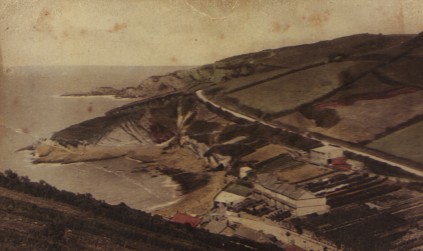
The Territorial Volunteers left Ilfracombe on 8th August 1914 for France, and many didn’t return. WW1 had a huge impact upon the town and the War Memorial records that 157 local men were killed. The lack of people meant few changes in Hele during and after the war; this postcard of Hele Bay (left), from around 1923, shows that very little has altered since 1906. Part of the golf course was ploughed over to help the war effort (it was restored in 1920) and Watermouth castle was used as a convalescent home for Army officers.
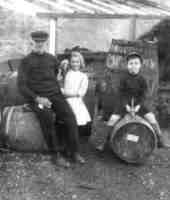 The guns on Hillsborough are said to have
been buried, so that Ilfracombe could not be classed as a fortified town, which,
by the 'rules of war', could be fired upon. But very occasionally the war brought some
local benefit: old William Lewis found some kegs of coconut oil on the beach,
worth a considerable £10 in salvage (right). It is said that during the war, the
former coal
store beside the beach, was used as garaging by the Cavendish
Hotel and after the War, two
former WRACS, Miss Barbeary and Miss Hooper, opened it as a cafe
called The Better Hole. (1)
The guns on Hillsborough are said to have
been buried, so that Ilfracombe could not be classed as a fortified town, which,
by the 'rules of war', could be fired upon. But very occasionally the war brought some
local benefit: old William Lewis found some kegs of coconut oil on the beach,
worth a considerable £10 in salvage (right). It is said that during the war, the
former coal
store beside the beach, was used as garaging by the Cavendish
Hotel and after the War, two
former WRACS, Miss Barbeary and Miss Hooper, opened it as a cafe
called The Better Hole. (1)
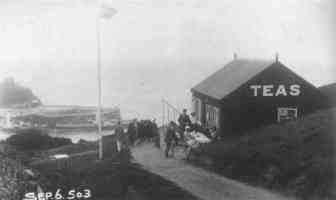 Hele Bay started to develop again
in the 1920’s. In 1920 Mr Widden (or Whidden) was given a licence to
operate a tea room on Hillsborough (left),
which continued until it was blown off the cliff in 1938; the concrete base is still there. In 1921 a second Post Office was opened at the top of Beach Road,
after which the old Post Office, at 18 Watermouth Road, closed. (2)
Hele Bay started to develop again
in the 1920’s. In 1920 Mr Widden (or Whidden) was given a licence to
operate a tea room on Hillsborough (left),
which continued until it was blown off the cliff in 1938; the concrete base is still there. In 1921 a second Post Office was opened at the top of Beach Road,
after which the old Post Office, at 18 Watermouth Road, closed. (2)
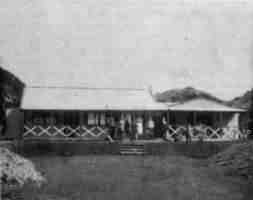 The golf
club pavilion was greatly extended in 1924 (right) and the golf
course redesigned in 1928/9. The most westerly part of the course was abandoned and two
'platforms' can still be seen on the hillside above Hockey Corner, the green
and bunker of former tee 16. In late 1923 - early 1924, an upper floor was added to Lewis’s Beach Tea Rooms, despite strong objection by
Sally Galliver,
and it was reopened (below left) as Nat Lewis’ Cafe. (2)
The golf
club pavilion was greatly extended in 1924 (right) and the golf
course redesigned in 1928/9. The most westerly part of the course was abandoned and two
'platforms' can still be seen on the hillside above Hockey Corner, the green
and bunker of former tee 16. In late 1923 - early 1924, an upper floor was added to Lewis’s Beach Tea Rooms, despite strong objection by
Sally Galliver,
and it was reopened (below left) as Nat Lewis’ Cafe. (2)
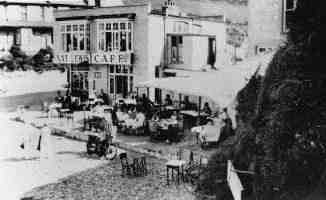
There was a strong community spirit in Hele and a committee was formed to provide enjoyment for children, which became a yearly event known as the Hele Revels. In 1927 the mill owner, Luther Salway, who lived at what is now Moles Farmhouse, renovated the mill, raising the roof, renewing the cogpit gears and replaced the wooden water wheel with a cast-iron one made in Barnstaple. In the late 1920's or early 1930's the Council built a row of seven semi's (14 homes) along Higher Hillside Road (below right), that were demolished following a landslip in 1980. (3)
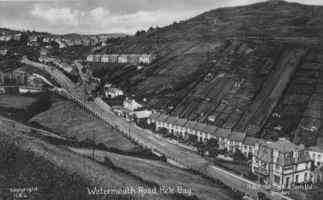
The Council bought what was left of the Royal Manor of Ilfracombe, the Weld Estate, in the early 1930's. This included the foreshore from Capstone Hill right around to Rapparee Cove, and Brimland's, which was levelled in 1934 and opened as playing fields in 1935. The Council widened Watermouth Road in 1932/3, on the landward side (right). Apart from the second floor on Lewis', the area around the beach remained much as it was in 1906 (below left).
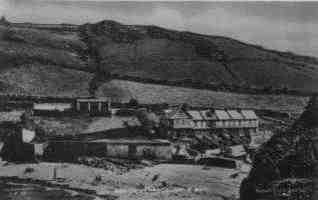 A photograph from c1933
is the first direct evidence of camping beside the beach. The first
advert in the Ilfracombe Guide for camping here was in 1935, but even in 1931 there
were sufficient visitors for Mr Lewis to rent out deck-chairs. In
1933 there was a fascinating article in the Ilfracombe Chronicle referring to
the growing popularity of Hele and discussing some of its history, reproduced in
full below. (4)
A photograph from c1933
is the first direct evidence of camping beside the beach. The first
advert in the Ilfracombe Guide for camping here was in 1935, but even in 1931 there
were sufficient visitors for Mr Lewis to rent out deck-chairs. In
1933 there was a fascinating article in the Ilfracombe Chronicle referring to
the growing popularity of Hele and discussing some of its history, reproduced in
full below. (4)
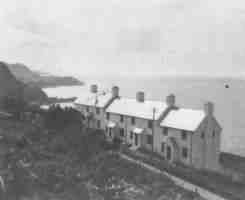 The Coastguard cottages
(right) were built above Rillage Point
in c1933, ironically placed above what was said to be a smuggler’s cave. In
1934 the 'banks' were removed from the south side of Ilfracombe High
Street and it is said that the 'deads' were taken to Hele to build the
promenade. Presumably the toilets on the promenade were built at the same time. A stone shelter
was later built on the promenade in memory of Nathaniel Lewis and his wife; who donated the land. The
promenade diverted the course of the stream, allowing sand to build up on the
beach. There were benches on the promenade (below left) which were
removed during WW2. (5)
The Coastguard cottages
(right) were built above Rillage Point
in c1933, ironically placed above what was said to be a smuggler’s cave. In
1934 the 'banks' were removed from the south side of Ilfracombe High
Street and it is said that the 'deads' were taken to Hele to build the
promenade. Presumably the toilets on the promenade were built at the same time. A stone shelter
was later built on the promenade in memory of Nathaniel Lewis and his wife; who donated the land. The
promenade diverted the course of the stream, allowing sand to build up on the
beach. There were benches on the promenade (below left) which were
removed during WW2. (5)
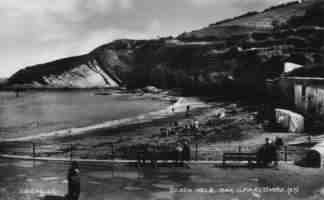
The former coal store was converted into The Fort Cafe in 1936 (below right) which was first advertised in the Ilfracombe Guide of 1937. A rear stairs were added and there was a dumbwaiter to carry food up to the flat roof above. The golf course was redesigned again in 1938, apparently to shorten the walking between tees, since there was only one instruction to the Architects, "Once up, once down!". (6)
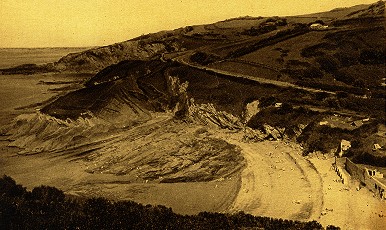
During WW2 Ilfracombe became a garrison town, mostly for the American Pay Corps. The Americans occupied part of the golf course, which was again reduced to nine holes (restored after the war with £70 from the War Office). The club lost all of their staff and the members complained of the long grass, especially as golf balls were not manufactured during the war. Hele Beach was covered in barbed wire and the slipway and promenade are said to have been protected by concrete tank traps. There was a Coastguard lookout station at Widmouth, which can still be seen just above the coastal path. Woolacombe and Braunton Burrows were major D-Day training areas and PLUTO (the Pipe Line Under The Ocean), the oil supply pipeline to Mulberry Docks, was tested between Watermouth Cove and the Mumbles in south Wales. (7)
During the war, the mill could not be supplied by boat and began to fall into decay. It was used only to grind a little animal feed and drive a domestic electric generator. It never recovered after the war and its owner, Bill Brigg's, died from contracting Weils disease (carried by rats). The former owner, Luther Salway, is said to have died from silicosis; and the miller before that, whose "name is never mentioned", according to The legend of the Three Millers (it was Thomas Watts), died a horrible death when his clothes were caught in the cogs. (8)
(1) WW1 1914-1918
August 4th 1914 saw the declaration of war. At Ilfracombe, Lynton and Westward Ho! 14 German and Austrian waiters and musicians were arrested as enemy aliens. (IMN 2000 p 14)
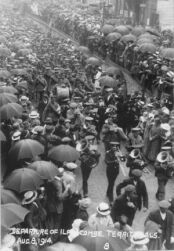 Territorials leaving Ilfracombe, from Lamplugh 1996 p 77, which has the caption "Led by the band, the column of Territorial's marches down the High Street on
their way the station, on an evidently wet day in August 1914". Another
view of the same procession has the caption "Saying goodbye
to the troops. Many of the crowd stood on the bank to get a better view of the
local Territorial's as they marched to their embarkation point for France on
August 8th 1914. Many of these soldiers did not return"(Horridge 1986 p 26)
Territorials leaving Ilfracombe, from Lamplugh 1996 p 77, which has the caption "Led by the band, the column of Territorial's marches down the High Street on
their way the station, on an evidently wet day in August 1914". Another
view of the same procession has the caption "Saying goodbye
to the troops. Many of the crowd stood on the bank to get a better view of the
local Territorial's as they marched to their embarkation point for France on
August 8th 1914. Many of these soldiers did not return"(Horridge 1986 p 26)
Another picture has the caption "The entire population turned out to give the Territorials a rousing send off and Reverend Johnson of Parish Church gave them all a blessing. General Williams RE of the Indian Army had opened proceedings with an address given to the soldiers who had received mobilisation papers only three days before. ....The Territorials then marched up to the Station and gave assistance in loading their 36 horses into five live stock trucks provided. The Battery consisted of 5 officers and 125 men and 4 guns and wagons. They left the station at 6pm bound for Plymouth, then war. A further 29 Lynton horses joined at Barnstaple" (Bartlett 1995 p 34)
"By order of the War Agricultural Committee, the top of the course was ploughed up in a bid to help the war effort. The course was restored to eighteen holes in 1920". (Ilfracombe Golf Club website 2002 www.ilfracombegolfclub.com also in Ilfracombe Golf Club brochure, Centenery Year 1892-1992, Rotapress, Chapel Lane, Combe Martin p 5)
"Annual General Meeting 1919: A resolution in favour of Sunday golf was moved by Mr Deacon and seconded by Mr Drake-Goodban, it being stated that some visitors desired this innovation. It was decided (Mr Foster opposing) to take the vote by ballot. Several members spoke in favour of the proposal and Mr Cooper asked if it meant any Sunday labour. Mr Deakin said that Groves, the groundsman, was quite willing to attend on Sundays and, if not, he himself was prepared to attend. Mr Foster opposed the resolution entirely. Whatever might be urged on behalf of golf for local businessmen occupied at work, did not apply to visitors who had all the week at their disposal. There were more important links than those of Ilfracombe where no Sunday play was allowed. On being put to the vote, the resolution was carried by 17 votes to 1" (Ilfracombe Golf Club brochure, Centenary Year 1892-1992, Rotapress, Chapel Lane, Combe Martin p 5)
"Bill Lewis, a Hele fisherman, accompanied by his grand-daughter May and Grandson Billy, was very proud to pose with these kegs of coconut oil, which he had recovered from the sea at Hele Bay in around 1918. As salvage, these kegs brought a reward of £10, a great deal of money in those days" (Pullen & Harding 2003 p 101) caption to photograph of Bill Lewis, shown above.
Tinted postcard of Hele Bay from Hillsborough, shown above (Cecil Hancock) says Ilfracombe, Hele Bay and 60276 on the front and copyright Photochrom Co. Ltd, Royal Tunbridge Wells on the back, with 1D George V stamp (1910-1937), postmark illegible. A black and white version of the same postcard (A Galliver) is postmarked 1st September 1926, with George V 1d stamp and the message "Somerset was glorious Devon is less kind. The hills of the people take more out of you! They are all complaining about losses owing to the coal strike. We have been putting up at very divers places. Weather V. [very] oppressive & seeming mists by day. Today dull but blowy. Kind regards to every-body in office. Any Telegrams?", addressed to "Messrs Hugo Lorenz Ltd, 7/8 Idol Lane, London EC3". This is before 1924 when the golf pavilion was extended and before c1924 when the 2nd floor was added to Lewis’. The building over the cave now looks like a greenhouse, and has been rebuilt since 1908.
1924 -"On armistice day Lord Fortesque unveiled the war memorial on the south slope to the parish church. Bronze panels bearing the names of the 157 men from Ilfracombe parish who had died on active service during the war are to be affixed later" (IMN 2000 p 16)
"War broke out in September 1914 and by October 28 the Penn Curzons had opened Watermouth Cottage in the grounds of the castle as a reception home for Belgians wounded in the first encounters between Allied and German troops. This lasted only a few weeks before 'other arrangements' were made and the Belgians were moved on - replaced by NCOs and men from the British Army. Small numbers from this group occupied the cottage through 1915 and up until March 1916 - and the general feeling of those who had ended up here after going through the Army medical system was that 'Watermouth was the gem of the journey'.... Accommodation in the cottage was limited so the Penn Curzons decided to use the whole of Watermouth Castle as a convalescent home - for officers only. From March 1916 until September 1919, when it was closed, just over 600 men passed through..." (Christie's History, North Devon Journal, Page 58, Sept. 11th 2003)
(2) 1920’s Hele Bay; Whidden, Shops, Golf course, Lewis'
Whiddens, Hillsborough
A photograph of Whidden's Tea Room c1925, shown above (Bartlett 1995 p 82, taken 1925-30, Postcard by Real Photographic Postcard, reproduced by kind permission of Tom Bartlett Postcard Collection, Berrynarbor, EX34 9SE) with caption "This refreshment hut was erected half way up on Hillsborough, just beyond the wall boundary of the field beyond the new covered swimming pool (opened May 1974). Mr Whidden was granted the lease for such a venture and on the basis that all the costs including erection would be at his cost, the rental agreed was £20 per annum and the hut was removed in the late forties or early fifties". This was just below the western end of the Iron Age earthworks; the concrete base is still there.
Another view of Widden’s taken at about the same time, has the caption "The Hillsborough Estate, extending from Rapparee Cove to Hele Bay, was purchased for £7,500 in June 1895 by the Ilfracombe District Council. In May 1920 the Council agreed to allow a Mr W H Widden to erect a refreshment room, which was a welcome stop on a walk to Hele" (Pullen & Harding 2003 p 67)
"A small tearoom existed on Hillsborough by 1925" (Walls 2000 p 8)
"The Tea Room was blown over and carried by gale force winds right over the cliff face of Hillsborough in 1938 and Mr Whidden removed any remnants of the room and did not renew the lease!" (Tom Bartlett, personal communication 2nd November 2003)
Shops
Number 4 beach road was converted from a private house into a post office in 1921 (still running in 1986) (Campbell 1986 p 18)
The two shops 18 & 19 Watermouth Road were built in 1900. No 19 was originally a shoe menders, then became a grocers in 1933 and a laundry 1971. No 18 was a Post Office & store until the second Post Office opened [4 Beach Road] in 1921 (Campbell 1986 p 25)
Ilfracombe Golf Course
May 3rd 1924 - "The annual meeting of the Ilfracombe Golf Club was held in the Board Room of the Tunnels Baths, Dr . C. W .E. Toiler presiding. The Honorary Secretary (Mr. G.R. Drake-Goodban), in the course of his report, stated that the progress of the club during the past twelve months had been excellent. The clubhouse had been extended and he thought that everyone would agree that the extension had proved most useful. It had been repainted and lighted and new gas stoves had been installed. Thanks were due to Mr. J. Armstrong (Manager of the Ilfracombe Gas Co.) for his advice and assistance in connection with the latter. The telephone had been installed and had been used frequently. During the year, the club had received a visit from James Braid, the famous professional golfer. This visit had been a splendid advertisement for the club. He had spoken very highly of the course and had since written that he would be very pleased to visit Ilfracombe again if possible. The new pavilion and the work in connection with it had cost nearly £900, much the larger part of this having been lent by members of the club. They had purchased some new mowers, which outlay of course would not occur again"
June 1924 - "the minutes showed
that HMS Coventry had paid a visit to Ilfracombe. With reference to the above
visit, from June 24th to 27th, Mr. G.R. Drake-Goodban had received the following
letter:-
Dear Sir ,
Please allow me, on behalf of officers of HMS Coventry, to thank your committee
for making us honorary members of your club during our visit to Ilfracombe. All
who played on the links enjoyed themselves and, in particular, those who played
in the match on Thursday, June 26th.
Yours faithfully, G.H. Baird Rear Admiral (D) Portland, July 1st" (Ilfracombe Golf Club website 2002
www.ilfracombegolfclub.com, also Ilfracombe Golf club Centenary Brochure 1892-1992,
Rotapress, Combe Martin p 7 & 9)
A picture of the Ilfracombe Golf Club house in 1924 (Ilfracombe Golf Club Centenary Brochure 1892-1992, Rotapress, Combe Martin p 9) has the caption "Clubhouse 1924"
"Development of the clubhouse and the course during the 1920's culminated in the acquisition of more land at the top end of the course, which allowed the then greens committee and Professional, Mr Groves, to design a new 18 hole course...This course opened in 1929." (Ilfracombe Golf club Centenary Brochure 1892-1992, Rotapress, Combe Martin p 11)
A plan of the golf course in 1929, compared to earlier plans, shows that two tees to the west of the clubhouse (tees 8 & 9 in 1903, becoming 16 & 17 in 1911) were abandoned when the course was redesigned (Ilfracombe Golf club Centenary Brochure 1892-1992, Rotapress, Combe Martin) There are two 'platforms' here that can still be seen on the side of the hill; one is probably the green for tee 9, the one higher up the hill is shown as a bunker.
Lewis'
December 1923 - Miss Sally Galliver took court proceedings against Nat Lewis in respect of his cafe enlargement plans as building another storey would interfere with her property. On hearing the case the judge ruled in favour of Nat Lewis (newspaper cutting, December 1923, A Galliver)
An advertisement in the 1924 Ilfracombe Chronicle, April 19th "Visitors will be pleased to know that NAT LEWIS' CAFE at Hele Beach, is now open for Hot or cold Luncheons, Teas a Speciality. This Cafe has recently been enlarged and redecorated throughout. The upstairs dining room has five large bay windows, from which magnificent land and sea views are obtained. Ladies and Gent's cloak rooms"
The photograph of Nat Lewis' Cafe, shown above, is from Ilfracombe Museum (ILFCM 9223). It has c1930 written on the back.
"In the 1930's Nat built on an upper part to the Tea Rooms which later was used for dancing. The local teenagers would think nothing of walking out from Ilfracombe to Nat's Caff, for a wonderful time dancing to the melodious violin of one Charley Butler - all for the sum of sixpence. Nothing stronger than lemonade was served" (ICTG 1985-6 p 3)
(3) 1920's Hele Bay: Revels, Mill, Council Houses
Hele Revels
"About the 1920's a committee was formed by the people of Hele to arrange and provide enjoyment for the children. This was such a success that it was always an annual affair and was called Hele Revels. There was maypole dancing in the meadow behind the school - the piano being hauled out be several stalwart men. The girls were dressed in white, with coloured sashes and garlands of paper flowers in their hair. Then there was a tug-o-war for the men with an accompaniment of "Oooh's and Aarrs" and "haeve-ho's" with much shouting and sweating. After that excitement came The Tea - this was laid on trestle tables with lots of cut-rounds, jam, cream, sponge cakes, biscuits, etc, especially for the children. In the evening the parents moved over to Nat Lewis Cafe, and so everyone had a very happy time" (ICTG 1985-6 p 4)
Hele Mill
"Inside is the mill mechanism built by Glideleh and Squire early this century built mainly of cast iron with wooden teeth and assembled on a 12' x 12' wooden chassis" (from typed article, Hele folder, probably by C Lovell, undated)
"In 1927 the roof was raised about 3 feet to provide more storage space, the wooden water wheel was replaced by the cast iron one made by Garnish & Lemon of Barnstaple, and most of the gears were replaced... The cogpit is the gearbox of the mill where the 7 revolutions per minute of the water wheel is converted to 28 revs/minute to drive the main horizontal shaft (in most British mills this is vertical) and this is stepped up to 112 revs/minute to drive two vertical shafts which run through bearings in the lower fixed millstones and drive the upper stones...The three large cast iron wheels each contain 104 wooden teeth. The advantage of wood is that if it breaks it can be easily replaced by the miller.....The wheel is cast-iron with wooden buckets made of elm. It was made in Barnstaple and installed in 1927 when the mill was modernised. It replaced a wooden wheel. It is 18 feet diameter, 44 inches wide. 56 buckets are held in place by 448 bolts. Each bucket holds 8 gallons, but at the design speed of 7 revs/minute each bucket is less than 1/4 full" (Guide to Hele Mill, p 2 & 3, pamphlet from Hele Mill, probably written by Chris Lovell - Copyright Hele Mill 1994)
"Luther Solway was responsible for the modernisation of the mill in 1927, when the wooden waterwheel was replaced by the cast-iron one, made by Messrs. Garnish & Lemon, of Barnstaple" (ICTG 1985-6 p 1)
Council Houses
A row of 14 council houses were built on Hillsborough in the 1920’s (Campbell 1986 p 18)
(4) 1930’s Hele Bay; Weld & Brimlands, Road widening, Camping beside beach, 1933 Newspaper article
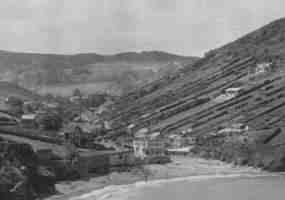 Postcard Hele Bay from Donkey Island c1930,
detail shown left, says on front "Hele Bay, Ilfracombe, Judges, Ltd" (Copyright
Judges Postcards Ltd., Hastings 01424 420919).
After Lewis second floor added c1924, before road widening c1932/3, before
promenade c1935.
Postcard Hele Bay from Donkey Island c1930,
detail shown left, says on front "Hele Bay, Ilfracombe, Judges, Ltd" (Copyright
Judges Postcards Ltd., Hastings 01424 420919).
After Lewis second floor added c1924, before road widening c1932/3, before
promenade c1935.
Weld Estate & Brimlands
The Weld Estate, the remaining of the Royal manor of Ilfracombe, was bought by the Council in the 1930's. A plan of the Weld estate and a schedule is in Ilfracombe Museum (Hillsborough folder).
In the Hillsborough folder, Ilfracombe Museum, are some papers detailing some of the history of Brimlands, as below:-
4th March 1930 - Ilfracombe UDC minutes - recommended that Brimlands be purchased, from Report of Pleasure Grounds Committee.
17th June 1930 - Contact of sale produced and council move to ask the Minister of Health for £2140 loan for the purchase.
This was agreed 9th Sept 1930 and on the same date it was agreed to levy 1d rate for levelling and laying out Brimlands as a sports ground and playing field, rescinded 7th October 1930.
7th July 1931 - Cricket & Rugby clubs request levelling of Brimlands.
3rd June 1934 - Council move to approach Minister of Health to borrow £750 for the levelling.
2nd Oct 1934 - Consent received. Council move that the footpath across Brimlands be moved, agreed.
30 July 1935 - Resolved "that Chairman of Council formally open Brimlands playing field on the occasion of the Sports on 20th August next"
Road widening
Watermouth Road was widened on its landward side, and railings erected, probably around 1931/2. It was after the golf club pavilion was extended in 1924 and just before the coastguard cottages were built c1933.
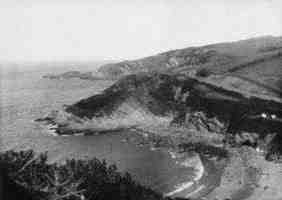 This photograph of Hele Beach and
Watermouth Road from c1933 (Ilfracombe Museum, Hele box ILFCM
23679J HOSKING) shows tents on the beach and on the edge of the cliff. It has
1930's handwritten on it . Another photograph of the same view (ILFCM 17262) has "1933" handwritten on the back. This
has also been produced as a postcard "Hele Beach and Haggington Foreland 4253"
by The R-A (Postcards) Ltd London EC4.
This photograph of Hele Beach and
Watermouth Road from c1933 (Ilfracombe Museum, Hele box ILFCM
23679J HOSKING) shows tents on the beach and on the edge of the cliff. It has
1930's handwritten on it . Another photograph of the same view (ILFCM 17262) has "1933" handwritten on the back. This
has also been produced as a postcard "Hele Beach and Haggington Foreland 4253"
by The R-A (Postcards) Ltd London EC4.
The photograph of Watermouth Road c1935 above, is from Ilfracombe Museum, postmarked August 1938 (ILFCM 26095A). There is a copy in (Bartlett 1987 p 47, Postcard Raphael Tuck & Sons c1906). Says copyright H.B. 6 (or 4) on the front. Bartlett dates this c1906 but it must be later because the new congregational chapel was not built until 1913. Also shows council houses of 1920's and road widening of 1931/2. Shows 'sheds' where Hele Billy's is now, possibly a garage or blacksmith? Probably the same series as another picture of Hele Beach c1935, also shown above (Cecil Hancock, says 'Copyright H.B.23, Beach Terrace, Hele Bay, Rapheal Tuck & Sons Ltd, London’ on front, and on back it adds ‘Real photograph, Art publishers to their Majesties the King and Queen and to HRH the Prince of Wales’)
Tourism
June 5th 1931 - Council discuss Nat Lewis’ application to rent deck chairs on Hele Beach (IC 5 June 1931 P3 col4)
Advert in 1935 Ilfracombe Guide "CAMPING! CAMPING! Full particulars, Bonnicott, Hele. Sea front." (lfracombe Museum, Ilfracombe Guide box) - First advert for camping in Hele Bay.
Ilfracombe Chronicle article September 1st 1933
"GROWING POPULARITY OF HELE BEACH. Fascinating History of Manor-Farm and the Mill SMUGGLING DAYS RECALLED. Does a native fully appreciate the beauty and romantic history of this corner of North Devon? This question is prompted by a letter which appeared in the Chronicle recently, in which a visitor asked for information concerning the history of Ilfracombe's rising suburb, Hele, and the difficulty which a Pressman experienced in ascertaining hard facts. "Some of the questions caught me guessing," he writes, "and my talks with Heleites provoked much inquisitive head-scratching." Setting out to obtain what must be regarded as only an apology for a complete answer to our visitor's questionnaire, I strolled eastwards away from the din of busy streets into the quiet and lazy atmosphere of Chambercombe woods. There, in front of me, stood the old manor farm. To the least observant person this 11th century building which still retains much of its original architecture in a wonderful state of preservation, must have its appeal, and it is not until one knows the history of the old building, the seat of the Champernowne's since Sir Henry de Champernon was in possession of it when lord of the Manor of Ilfracombe in 1162, that one can appreciate its antiquity. Like most old buildings, a legend has been woven about its fabric. A room, adjacent to the one said to have been occupied by Lady Jane Grey, is supposed to be haunted. The story concerning that part of the house is that in 1865 the then tenant was making some repairs to the outside of the building when he discovered the outline of what had been a window and for which he could not find a room appertaining. Investigation led to the discovery of a chamber between Lady Jane's and one adjoining, in which, on the remains of a handsome bedstead, lay the skeleton of a woman. She was supposed to have been a Spanish woman, who, having been wrecked near Hele, was captured by smugglers and conveyed through the secret passage which existed between Hele and the farm. It is supposed that she was robbed and left to die of starvation. The ghost of this poor lady is still said to haunt the room, and weird sounds are to be heard there at night (If our correspondent requires the full account of the legend he should refer to "The History of Chambercombe Farm" (6d).
The Old Mill Leaving the farm, where I spent an interesting hour and a half, thanks to the kindness of the owner, Mrs Loze, I tramped through Comyn Farm, on to the Hele Mill. Great interest surrounds this building, which has become more of a novelty than an antique. Still used for milling by the present owner, Mr L W Salway, it is over 200 years old. In early days the miller lived on the premises, but now the living rooms are used for the granary. The earliest known owner was a Mr John Hill (about 1830) who was a forbear of the present Salway family. In addition to his ordinary occupation Mr Hill was recognised as the village dentist and policeman. The baton he used when acting as custodian of the peace is preserved by Mr L W Salway, of Moles Farm. John Hill died in Jubilee year, and his daughter, familiarly known in the village as Granny Salway, died only last year at the ripe old age of 95 years. The original stones are still used for grinding, but a wooden water wheel has been replaced by an iron one. Donkeys carried the sacks of grist suspended across their backs. The mill stream tumbled over a stony bed down to the sea, and the only means of reaching the bay was by riding on horse or donkey down the water course or a narrow stone-flagged footway at the side. The stream now runs in a channel under the roadway. There is also another old and interesting building in the village, and it is known as Hele Cottage. Here beer was brewed in the old-fashioned way, and sold to visitors. Entering this old dwelling one's attention is arrested by a spacious room. What a story the four walls would have to tell if they could but speak - stories of gay scenes and dancing to the tune of fiddle and flute.
Coves and Caves Passing out of the part of Hele still known as the village, I wended my way to the beach, where I met an "old salt," one who has lived many a year in the native air. As we talked, his warm affection for the bay - which, in his eye, perhaps, has been sadly modernised - lit up his countenance. "About a hundred years ago," he explained, "lime was dug out of the cliffs, and the stones burned in local kilns." Those man-made holes have since, by the action of the sea, been transformed into miniature caves and coves. Many of these caves assumed the names of the old men who worked in them. There is one big cave under Hillsborough, on the Hele side, which was dug out for lime stone by old Hele worthies, and is known as Joe Moon's Cave. Joe Moon was a well-known local character. Blythe's Cove took its name from a Capt. Blythe who lived in Ilfracombe and who used to bathe at that part of the coast at all seasons of the year. He was a prominent local gentleman, and it is fitting that this cove, bearing his name should perpetuate his memory. Donkey Island was so called because the old washer-women of the village used to leave their donkeys there when not employed in delivering the laundry linen.
Smuggling Days It is only to be expected that this quiet and sheltered bay should be associated with smuggling. The very names of some of the beaches and coves remind us of these old beach-combers. Tom Normans Cave...Tom used to frequent this part of the shore about 120 years ago, and was connected with another well-known family named Pickett. Another name which conjures up visions of smuggling days is Sampson's bay - one of the most convenient spots along the coast for men who gained their livelihood by luring vessels to destruction. Sampson was a smuggler of repute. There is a path winding over the cliffs known as Jan White's - another name connected with smuggling. Among smuggler's tales is one concerning John Wilkey and Bill Stephens who tried to waylay a smugglers' wagon in the early hours of the morning, whilst it was on its way to South Molton, but, although they were successful in achieving a 'hold up', they were bribed by the smugglers, it is said, with gifts of silken goods. These smugglers were said to have been in league with the tenants of the old manor Farm at Chambercombe. Mr Nicholas Lewis, grandfather of Mr Nat Lewis, used to tell a story concerning his aunt who lived at the Manor farm as a servant. She declared that it was impossible to sleep at the old manor house after one o'clock in the morning because there were sounds resembling those made by rolling barrels, and old Mr Nicholas Lewis contended that there was a secret passage underneath to Rapparee beach. It was there that a Spanish vessel went ashore, and that probably accounts for the story concerning the skeleton of a Spanish lady found at the old manor farm, and who was supposed to have been washed ashore from a wreck.
Hele Worthies I also had a chat with Mr Nat Lewis, who has many interesting memories of the old days. He, too, told me how lime was dug from the cliffs, and how pack ponies carried the stones up the narrow mountain paths to the lime kilns. Lime-burning was then an important industry in Hele. Sailing vessels brought to the village culm from South Wales for burning the lime, and many a vessel had its bottom battered in trying to get into the bay during a rough sea. Here are some old names, each one a story in itself: Tom Lewis, Tom Pedrick, John Wilkey, the Moon's, the Galliver's, the Rattenbury's, John Colwill, James Scamp, the Hardings, and the Peaks. It might be mentioned that yacht-building was carried on at Hele for many years by the Lewis family, and among the yachts were the Saucy Lass, Foam, Blue Ribbon, Teaser and Maud. "Gran'fer" Lewis, a man named Gibbs, Mr W Rudd's father, and the late Mr Geo. Bowen's father helped, with others, to cut the path around Capstone hill and put up some of the stone-work of the pier. And so the story of Hele Bay and its worthies goes on, and can only end where memory fades. Much of its history is lost with the passing of old inhabitants, two grand old ladies having passed away last year - Mrs Moule (94) and Mrs Salway (95). It is only in recent years that Hele has become a popular holiday haunt, and the catering business started with the supplying of kettles of hot water to the half-a-dozen or so visitors who found there way there. Hele, as it is today, is of recent growth, for the time is within living memory when only a handful of houses existed there" (Ilfracombe Chronicle Sept. 1st 1933 p 6)
(5) 1930’s Hele Bay; Coastguard Cottages, Promenade
Coastguard Cottages
The picture of the Coastguard cottages, shown above, is from Ilfracombe Museum (ILFCM 17894). It is the same as another (Bartlett 1987 p 50) with the caption "Built around 1930 these were fully occupied by Coastguard personnel right up to the late 70’s, but apart from the house marked with a cross, were all sold off a few years ago", which claims to be from a postcard postmarked 1934. Both pictures are marked with a cross, but seem to cover a different area; perhaps they are both copied from the same original.
Promenade
The postcard of Hele promenade 1932, shown above, (Valentines 218094.j.v Beach, Hele Bay, Ilfracombe (‘67)) shows benches on the promenade before the war and some bathing huts on the beach. Must predate 1937 when Fort Cafe first advertised and is after road widening 1931/2. According to the University of St Andrews, who hold the Valentines collection, it was registered in 1932.
"Two children watch the traffic from the bank opposite 19 and 20 High Street, looking west, in about 1905...This part of the bank was removed in 1934" (Horridge 1986 caption to plate 25). The ‘banks’ were removed from Ilfracombe High Street in the mid 1930’s (Swift 2001 caption of plate 43)
The shelter [on Hele promenade] has the following inscription "This site was given by the family in memory of Mr Nathaniel Lewis and his Wife".
The promenade is said to have been built when the 'banks' were removed from Ilfracombe. There are several articles about the banks in the Ilfracombe Chronicle 1934 (e.g. 9th February) which reveal that the banks were removed winter 1933/4 - but the deads appear to have been taken to Killicleave and there is no mention in any of the articles about the promenade in Hele.
(6) 1930's Hele Bay: Fort Cafe 1936, Golf course redesign 1938
Fort Cafe, Beachside
1937 Ilfracombe Guide has two adverts: "CAMPING! CAMPING! Full particulars, Sherwood, 4 Beach Road, Hele. Sea Front." and "THE FORT CAFE, Hele Beach, teas and cafe, personal attention" - This is probably the first advert for the Fort Cafe.
1939? Ilfracombe guide has three adverts, for Fort Cafe as 1937, also "CAMPING! CAMPING! Sea front, full particulars apply ‘Varley’ Chambercombe Park Road" and "’BEACHSIDE’ Hele Bay, Ilfracombe, Board Res., bed & brek., next sea beach, golf, JW Talamo" - This guide was probably used during most of WW2 since it has a typed inset listing the hotels that are closed.
A picture of the beach c1938, shown above, shows the coal store converted to the Fort Cafe (the back stairs have been added). There are bathing tents on the beach.
Golf Club
"One of the most notable events of the 1930's was the retirement in 1935 of the professional, Mr W H Groves. He had started work for Ilfracombe Golf Club when the club was still at Mullacott (1899). He began as a labourer who could use a scythe to cut the fairways! His wages were 12/6 (621/2p) a week, for one summer's work but he made such a good job of it and showed such an interest in it, that the club appointed him permanently - at a reduced salary of 7/6 (371/2p) a week. In the ensuing years, by visiting Mr Gibson, club maker at Westward Ho! Golf Club, Mr Groves became proficient in the art of making golf clubs and eventually he took over as professional. He was responsible for the construction of the course after the move from Mullacott and was involved in all the course developments up to and including that of 1938, when he was called out of retirement to supervise the work." (Ilfracombe Golf club Centenary Brochure 1892-1992, Rotapress, Combe Martin p 11)
"In 1938, after numerous complaints from members, more land was acquired, which is now the men's 8th and 14th tees and Messrs. Colt, Allison and Morrison, Golf Architects, were employed to redesign the existing course, with only one instruction from the committee: Up once, down once!" (Ilfracombe Golf club Centenary Brochure 1892-1992, Rotapress, Combe Martin p 11 & 13)
There is a map of the course 1938-1958 (Centenary Brochure 1892-1992 p 12)
(7) WW2 1939-1945
"The 1939 Carnival procession was to be the last to be held for six years. A tremendous feeling of foreboding seemed to dampen this usually exciting event. All the local Territorial's were on parade and it was evident amongst the crowds that there was a general feeling of anxiety and fear for the future. A week after the carnival the Territorial's left the town after a huge parade through the town to Ilfracombe Station" (IMN 2000 p 16)
During WW2 Ilfracombe became essentially a garrison town. The Royal Army Pay Corps occupied the whole of Ilfracombe Hotel. (Horridge 1986)
"In 1940 Ilfracombe played host to many displaced persons, and several service detachments began to arrive. All the hotels of any size were commandeered - Runnacleave, Osborne, Berkeley, Grosvenor, Dilkhusa Grand, Imperial, Collingwood, Granville, Carlton, Paragon, Gilbert and Mount Hotels. The Royal Army Pay Corps were the main contingent, they occupied the Runnacleave Hotel and the Ilfracombe Hotel as well as one or two others. ...A detachment of WRENS were billeted at the Cliff Hydro and the WRAC’s were at the Berkeley. Other Army units were the Pioneer Corps, The Royal Army Service Corps, Royal Corps of Signals and the ‘sharpshooters’ - regiment unknown" (IMN 2000 p 16)
"The Tunnels were made into air raid shelters for the children of the Hermitage and Church Schools. Air raid shelters and static water tanks were built in many parts of the town. RAF air/sea rescue launches were stationed in the harbour. Very large red and yellow rafts were in the harbour and were towed out into the channel and used for artillery and bombing targets. A battery of two heavy coastal defence guns were positioned between Larkstone and Rapparee beaches...A munitions factory was situated in Horne Park....Drifting sea mines were often towed into Larkstone harbour to be de-horned. After a storm many exploded along the coast, indeed one actually blew up on the rocks just past Rapparee" (IMN 2000 p 16)
Golf Course
"[During WW2] the course had to be reduced to nine holes through requisitioning of land by the War Office and the Agricultural Committee as a training area for troops and for food production. Membership during the war years was maintained through personnel of the armed forces in the town, in particular the Army Pay Corps, which was stationed here permanently. With the closure of Saunton Golf Club, owing to requisitioning, many of their members used the facilities of Ilfracombe Golf Club until their course was restored to them after the war. The club at this time lost all the staff, including the groundsmen and the professional, to the armed forces and as a result had to hire farmers to cut the course, a rather haphazard arrangement which led to the loss of quite a few golf balls. This added to member's problems as golf balls were not manufactured during the war years, or for several years afterwards, because of the necessary rubber content being in very short supply" (Ilfracombe Golf club Centenary Brochure 1892-1992, Rotapress, Combe Martin p 13)
"When the war ended in 1945, our course was restored, once again, to 18 holes, helped by a payment from the war office of £70, to repair damage to the course caused by the army" (Ilfracombe Golf club Centenary Brochure 1892-1992, Rotapress, Combe Martin p 14)
D-Day preparations
A map of major military installations of WW2 shows coastguard stations at Croyde and Widemouth Hill, large training areas in Braunton Burrows and Woolacombe. (Blacksell, Mark 1999 Defence & Disruption, the first and second world wars in Kain & Ravenhill 1999 p167)
In 1944 the trial, at Watermouth, of Pluto (Pipe Line Under The Ocean) to Mumbles in south Wales, to carry fuel across the channel for the D-Day invasion. The trial was 40 miles long (the final one nearly 100 miles long) (CMLHG 1989 p 19)
"PLUTO, the pipeline under the ocean, so vital to the D Day landings, was tested from South Wales into Watermouth" (IMN 2000 p16)
There is a folder on PLUTO in the Ilfracombe Museum.
"Most of the training for a D-Day landing took place on Woolacombe beach, landing amphibious craft, sometimes in rough weather and there were many fatalities during the landings. During this time the whole beach was closed completely to the public and photography was strictly forbidden. Gradually in the March, April and May of 1944 it was pretty obvious that the troops wouldn’t be staying much longer. At midnight on June 1st 1944 there was an almighty noise as all the vehicles had their engines started...by morning the whole of the Torrs was empty" (IMN 2000 p17)
(8) Hele Mill
"But within about 20 years [of the 1927 refit] the mill began to deteriorate. Most of the grain came by sea and the effect of WW2 put the mill almost out of action. During the war it was used only to drive a small generator [which fed Hele House, now Moles farmhouse] and grind a little animal feed" (Guide to Hele Mill, p 2, pamphlet from Hele Mill, probably written by Chris Lovell - Copyright Hele Mill 1994)
"Bill Briggs was the miller at Hele in 1948. One day a rat seized him by the throat and he died as a result of the bite. Before him, his father in law, Luther Solway was the miller, responsible for the 1927 restoration, and he died of silicosis caused by breathing flour dust. The miller before him is not mentioned by name and it is believed that his coat was caught in the cogs and he was 'slowly mangled to death, screaming but unheard'" (The Story of the Three Millers, pamphlet from Hele Mill, probably written by Chris Lovell in 1978-94)
"The mill was used for grinding animal foods during the second world war. Solway's son-in-law was the miller at that time, Bill Briggs. He died after contracting weil's Disease (contamination from rats). His son had also died during the war years. The mill, mill-house and land were sold. Within 20 years of the mill being restored, the War years, the change of use of the mill, due to the cost of haulage of materials by road, and the change in shipping, and the Governments direction of foodstuffs, the mill began to deteriorate" (ICTG 1985-6 p 1)